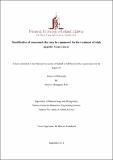| dc.description.abstract | Triple negative breast cancers (TNBC), lack the estrogen and progesterone receptors as well as the HER2 receptor. Currently, there is no selective therapy for the treatment of TNBC and current treatment regimens rely on a cytotoxic chemotherapeutic approach. In addition, many TNBC's display markers of clinically relevant drug resistance, which contribute to the difficulty of treating the disease. Thus, there is a need for the development of new drugs. Current drug discovery is a labourious, costly and time-consuming process with a high attrition rate. Repurposing is an attractive alternative, as many clinically approved compounds have activities unrelated to their current application, that can be harnessed for the treatment of an alternative clinical indication. Here, the Johns Hopkins Clinical Compound Library (JHCCL), consisting of ~1,500 clinically approved and off-patent drugs, was screened against the multi-drug resistant (MDR)-TNBC cell line MDA16. The aim was to identify compounds that caused collateral sensitivity or compounds that displayed novel and/or effective activities against the TNBC cell lines. Three related antimetabolite drugs cytarabine, gemcitabine and cladribine were identified to cause collateral sensitivity. However, collateral sensitivity has been well documented with this class of drug and because of this lack of novelty, their activities were not further characterised. The antibiotic anisomycin (ANS) was identified as the most effective compound from the secondary screen. ANS was found to be highly effective against a subset of TNBC cell lines and against some prostate cancer cell lines in vitro. In the MDA-MB-468 TNBC cell line, ANS was shown to induce ribotoxic stress, as evidenced by JNK activation, with induction of caspase-3 like activity and caspase-3 processing as reported in the literature. However, induction of ribotoxic stress and caspase activity is not required for cell death as blocking ribotoxic stress signalling and caspase activity failed to protect cells from ANS induced cell death. These results are contrary to the published literature relating to the mode of cell death in response to ANS treatment. Thus, these findings are novel and increase the repurposing potential of ANS for the treatment of TNBC. | en_US |


